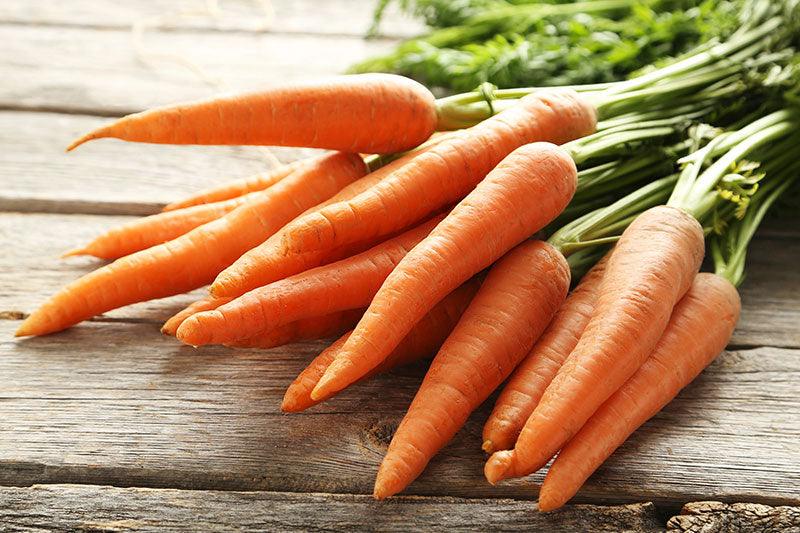








- Description
- Which ingredients do we use & why?
- Why Cooked Food?
- Feeding Guide
For our fresh menu with salmon, we exclusively use fresh, food-grade ingredients in our in-house manufacturing. High-quality salmon is slowly and gently cooked at low temperatures. Only after that, we mix blanched sweet potatoes, carrots, peas, zucchini, and apples, along with salmon oil, rose hips, algae lime, brewer's yeast, seaweed meal, and sage into the cooked food. This ensures that both the flavor and nutrients are optimally preserved.
No high temperatures, no fillers, no artificial vitamin additives, no extrusion, no sterilized cans. The result: Like home-cooked, healthy food with all the nutrients from the fresh original ingredients, it tastes as good as it looks. 100% natural and 0% artificial additives. Developed with veterinarians and made with love. Simply the best food for your dog. This creates an incomparable, healthy fresh menu for your dog. Just like home-cooked.
Composition
70% cooked salmon, 7.4% sweet potatoes, 6% carrots, 6% peas, 4% apples, 3% zucchini, 1.5% salmon oil, 1% beef liver, 0.4% rose hips, 0.4% algae lime, 0.1% brewer's yeast, 0.1% seaweed meal, 0.1% sage.
Analytical Components
Proteins 13.8%, Crude Fat 9.6%, Moisture 63.1%, Crude Ash 2.6%, Crude Fiber 1.2%.
Supplementary dog food.

Freshly Cooked Salmon (70%)
Regular consumption of salmon can also reduce the risk of strokes and heart attacks in dogs. Salmon provides valuable Omega-3 fatty acids that are essential for your furry friend. Omega-3 promotes skin and coat health, strengthens the immune system, and can enhance brain function. Additionally, it supplies your dog with vitamins A, B6, B12, D, and E. It also provides minerals like niacin, pantothenic acid, calcium, magnesium, iodine, and selenium, which strengthen his skeleton and muscles, among other things.

Sweet Potatoes (7.4%)
According to the American non-profit organization Center for Science in the Public Interest (CSPI), sweet potatoes are considered the healthiest vegetable overall. The greatest benefits of sweet potatoes are their high content of secondary plant substances, which protect against free radicals. They are a source of minerals and vitamins and contain many high-quality fibers.

Carrots (6%)
In addition to energy, fiber, and low calories, carrots are healthy because they are an excellent source of vitamins and minerals. In particular, vitamin A and biotin are worth mentioning. Carrots are rich in beta-carotene, which is converted into vitamin A in the body.

Peas (6%)
Peas contain many vitamins. In addition to beta-carotene, peas have a lot of B vitamins to offer, and vitamin C is also included. Peas also score with minerals: magnesium, iron, calcium, and zinc make them a particularly healthy vegetable side dish.

Apple (4%)
Apples are suitable for a healthy diet because they contain many vitamins, minerals, and trace elements such as potassium, calcium, B vitamins, vitamin C, vitamin E, folic acid, pectins, and polyphenols.

Courgette (3%)
Courgette have a particularly valuable content of calcium, magnesium, iron, B vitamins, vitamin A, and vitamin C. They have very few calories, making them a light but vitamin- and mineral-rich component of the vegetable kitchen.

Salmon Oil (1.5%)
Salmon oil is an important source of fatty acids, especially providing an adequate amount of omega-3 and omega-6 fatty acids. The addition of salmon oil can have some crucial effects that ensure a long and healthy life for your furry friend, such as improved fur or faster healing of skin conditions.

Beef Liver (1%)
Beef liver is particularly valuable because it contains a lot of iron and many vitamins (A, B2, B12, biotin, etc.).

Rose Hips (0.4%)
Besides vitamin C, rose hips also contain numerous other ingredients that have a positive effect on health. These include: fruit acids, essential oils, pectins, tannins, silica, the antioxidants lycopene and flavonoids, the vitamins provitamin A, vitamins B1 and B2 as well as vitamin E, the minerals zinc, copper, sodium, phosphorus, iron, calcium, and magnesium.

Algae Lime (0.4%)
Algae lime consists of deposits from red algae. It mainly contains calcium carbonate, as well as magnesium carbonate and trace elements (boron, iodine, silica), thus preventing a deficiency of minerals and trace elements. The high calcium content supports the stability of bones and teeth and balances the excess phosphorus from a meat diet, which can otherwise lead to kidney problems.

Brewer's Yeast (0.1%)
Brewer's yeast contains a lot of vitamins and minerals and is also a good source of protein. Additionally, it stimulates metabolism and helps maintain a constant blood sugar level.

Seaweed Powder (0.1%)
Seaweed meal contains many minerals such as zinc and carotenoids that support skin metabolism, pigmentation of fur, nose mirror, and paw pads. The contained amino acid lysine optimizes the nutritional value; cellulose and mannitol support digestion.

Sage (0.1%)
Sage stimulates intestinal functions and the gall bladder through its bitter substances. It promotes the production of digestive juices in your dog's stomach, which can help reduce bloating and digest fat more effectively.
Is everything in there?
As a holistic vet, Anita Kröger attaches particular importance to a species-appropriate, natural and varied diet when it comes to dog health. From the perspective of holistic veterinary medicine, nutrition plays a key role in a dog's long and healthy life. The vet and founder of the Centre for Canine Health specialises in the treatment of chronic diseases in addition to providing medical nutritional advice. She specialises in intolerances, allergies and gastrointestinal diseases.
The Fidelis Difference: Gentle Processing, Superior Quality
The gentle steam pre-cooking of our meat allows for sterilization in jars at significantly lower temperatures and shorter dwell times. This keeps the meat in nice, chunky pieces, not overcooked mush.
Thanks to the pre-cooking, less water evaporates during sterilization, eliminating the need for artificial binders commonly used in canned food. These binders, often not listed on ingredients labels, can potentially trigger allergies and other health issues.
By using only fresh, high-quality ingredients without binding agents, our fresh food in jars boasts a fresh, delicious aroma, a world away from the typical unpleasant smell of canned food. Gentle preparation also preserves more nutrients from the original ingredients, minimising the need for artificial vitamins with a varied diet.
Glass: The Healthier Choice
Fidelis fresh food in jars offers additional advantages over canned food. Glass eliminates the risk of metal particles or coating residues contaminating the food. Residues from tin cans have been linked to cancer and other diseases. Glass simply doesn't leach any harmful substances. It's no wonder baby food is primarily available in glass jars.
The glass are also resealable and bad odours from opened cans in the fridge are a thing of the past. The result: fresh-smelling, healthy, wholesome menus for a species-appropriate, varied and digestible diet for your dog. Just as practical as tinned food, only much better.
Fidelis Fresh Menus are thus absolutely unique and simply put: "Better Food" for your dog! We cook for your dog just like you would at home.
Disadvantages of other types of food
What are the disadvantages of other types of dog food compared to the cooked fresh menus from Fidelis?
Extruded/Cold-Pressed Dry Food::
Almost always made with a significant amount of grains, animal meals, and hardened fats. Fresh ingredients like meat, offal, and vegetables are used in very small quantities or not at all. The extrusion or cold pressing process heats the product to very high temperatures, destroying most remaining nutrients and minerals.
- Vitamins and minerals are artificially added.
- Dry food often contains preservatives and attractants.
Wet Food/Canned Food::
Most manufacturers use low-quality meat and slaughter by-products, plant by-products, and artificial additives for can production. Fresh ingredients like meat, offal, and vegetables are used in very small quantities or not at all. The sterilization process in autoclaves during canning heats the food to a temperature of 110–140°C, resulting in the loss of a large portion of nutrients and minerals.
-Vitamins and minerals are artificially added.
-Canned food often contains preservatives and attractants.
B.A.R.F. (Biologically Appropriate Raw Food):
The concept of feeding dogs biologically appropriate raw food, including meat, offal, vegetables, and fruits, has merit. However, raw, untreated B.A.R.F. products can be a significant problem. They are often contaminated with a high number of germs and bacteria, which can lead to intolerance or digestive difficulties for the dog and pose serious health risks for the owner during thawing and preparation. Enterobacteria and E. coli bacteria can cause severe health problems in both dogs and humans. The protein content in B.A.R.F. menus is often too high, leading to health problems in many dogs.
Daily Feeding Guide
This guide provides a starting point for the amount of food to feed your dog daily.
Puppies up to 8 months: approximately 4.5% of body weight
Dogs up to 15 kg: approximately 2.5-3% of body weight
Dogs over 15 kg: approximately 2.5-3% of body weight
Example: A 20 kg dog with a recommended daily allowance of 2.5% would need 500g of food per day (20 kg * 2.5% = 500g).
Please Note:
These are guidelines for healthy, active, non-neutered dogs. Individual needs may vary by up to 50% based on age, breed, or activity level.
Adjust the amount of food based on your dog's individual needs to maintain a healthy weight.
Transitioning to Fidelis
Fidelis recommends switching your dog's food immediately. Skip one meal (preferably in the evening) and start with our food at the next meal. Feed a single flavour for the first 14 days to allow your dog's stomach to adjust. After two weeks, you can alternate between different flavours.
Delivery & Storage
Our fresh menus in a glass are delivered to you in protective packaging with 6 glasses each. For this reason, the minimum order quantity is 6 glasses and then always 6 more. Our fresh menus in glass have a shelf life of at least 1 year. After opening, we recommend storing the menus in the refrigerator and using them within 3-4 days.
Both dogs really like their Fidelis salmon with sweet potato and peas.
Perfect as always. Nina is very grateful
Comes in a jar looks like the ingredients that is in it seems to be excellent quality.
Easy to get out of jar
Nina is allergic to meat products and she absolutely loves this food. If there are any more meat free products we would happily try them.
Product & Service absolutely 100%









